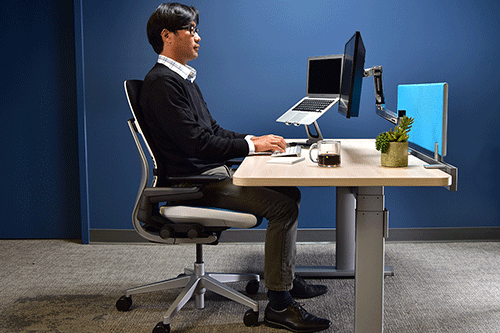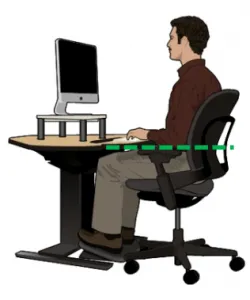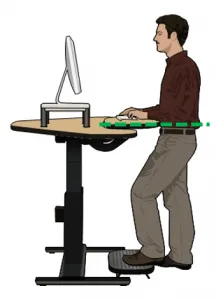How High Should My Desk Be?
Posted on February 4, 2020 | in Ergonomics

As an ergonomist, one of the most common issues I see at client sites is improper desk height, particularly desks that are positioned too high for individuals. If you’re working at a desk that is too high, you may notice that you elevate your arms, shrug your shoulders, extend your arms forward to use the keyboard/mouse, or rest your forearms on the edge of the tabletop. Compensating for the high desk height means holding these awkward upper limb postures for extended periods of time. In addition, resting your arms on the edge of the desk may restrict blood flow to the working hand and wrist muscles. In short, if your desk is too high, you may experience shoulder, elbow, wrist, or hand discomfort.
On the contrary, if your desk is too low, you may lean forward when you work or extend your arms forward to use the keyboard/mouse (especially if the armrests of the chair interfere with the desk). Again, you’ll find yourself in awkward upper limb postures for long periods, and you may end up sitting with an unsupported back. If your desk is too low, you may experience back, shoulder, elbow, wrist, or hand discomfort.
What is the optimal hand working height?
 To achieve the optimal hand working height—for both seated and standing work—position the keyboard and mouse at elbow height. To determine if you are working at your optimal hand working height, follow these steps:
To achieve the optimal hand working height—for both seated and standing work—position the keyboard and mouse at elbow height. To determine if you are working at your optimal hand working height, follow these steps:
- Relax your arms down at your sides.
- Keep your elbows close to your sides.
- Bend your elbows 90˚ so that your forearms are parallel with the floor.
You should be able to maintain this posture when typing, mousing, or writing at your desk.
How should you design ergonomic office workstations?
 For offices that have fixed-height desks, customize the height of the desk to the individual and position the keyboard and mouse at the person’s seated elbow height. If the desk is too high, raise the chair and provide an adjustable height footrest. If the desk is too low, place blocks under the legs of the desk to bring it to the proper height.
For offices that have fixed-height desks, customize the height of the desk to the individual and position the keyboard and mouse at the person’s seated elbow height. If the desk is too high, raise the chair and provide an adjustable height footrest. If the desk is too low, place blocks under the legs of the desk to bring it to the proper height.
For offices that have adjustable-height desks, make sure the desks provide the right amount of adjustability for the task: between 24″ and 29″ above the floor for a seated workstation, and between 24″ and 48″ above the floor for a sit/stand workstation.
Keeping your hands at elbow height will allow you to work with more neutral back and upper limb postures throughout the day. By following this guideline and properly adjusting your workstation, you will not only improve your overall comfort, but you’ll also experience a boost in productivity and work satisfaction.